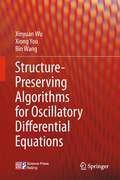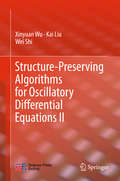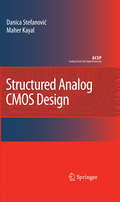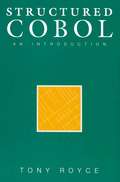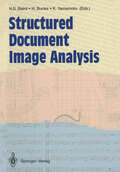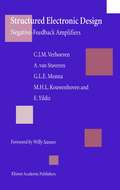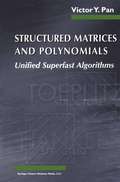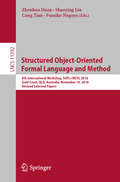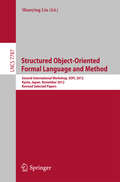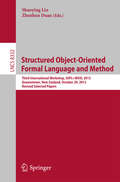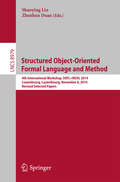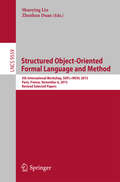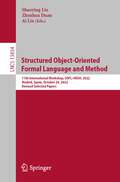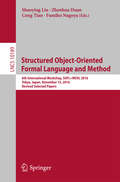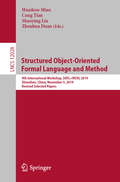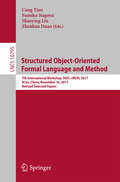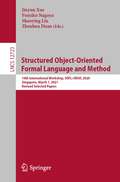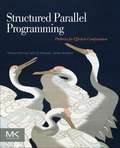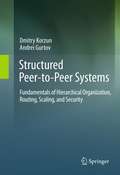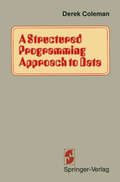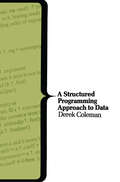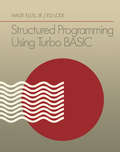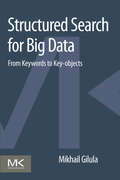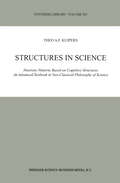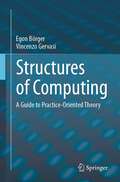- Table View
- List View
Structure-Preserving Algorithms for Oscillatory Differential Equations
by Xinyuan Wu Xiong You Bin WangStructure-Preserving Algorithms for Oscillatory Differential Equations describes a large number of highly effective and efficient structure-preserving algorithms for second-order oscillatory differential equations by using theoretical analysis and numerical validation. Structure-preserving algorithms for differential equations, especially for oscillatory differential equations, play an important role in the accurate simulation of oscillatory problems in applied sciences and engineering. The book discusses novel advances in the ARKN, ERKN, two-step ERKN, Falkner-type and energy-preserving methods, etc. for oscillatory differential equations.The work is intended for scientists, engineers, teachers and students who are interested in structure-preserving algorithms for differential equations. Xinyuan Wu is a professor at Nanjing University; Xiong You is an associate professor at Nanjing Agricultural University; Bin Wang is a joint Ph.D student of Nanjing University and University of Cambridge.
Structure-Preserving Algorithms for Oscillatory Differential Equations II
by Xinyuan Wu Kai Liu Wei ShiThis book describes a variety of highly effective and efficient structure-preserving algorithms for second-order oscillatory differential equations. Such systems arise in many branches of science and engineering, and the examples in the book include systems from quantum physics, celestial mechanics and electronics. To accurately simulate the true behavior of such systems, a numerical algorithm must preserve as much as possible their key structural properties: time-reversibility, oscillation, symplecticity, and energy and momentum conservation. The book describes novel advances in RKN methods, ERKN methods, Filon-type asymptotic methods, AVF methods, and trigonometric Fourier collocation methods. The accuracy and efficiency of each of these algorithms are tested via careful numerical simulations, and their structure-preserving properties are rigorously established by theoretical analysis. The book also gives insights into the practical implementation of the methods. This book is intended for engineers and scientists investigating oscillatory systems, as well as for teachers and students who are interested in structure-preserving algorithms for differential equations.
Structured Analog CMOS Design (Analog Circuits and Signal Processing)
by Danica Stefanovic Maher KayalStructured Analog CMOS Design describes a structured analog design approach that makes it possible to simplify complex analog design problems and develop a design strategy that can be used for the design of large number of analog cells. It intentionally avoids treating the analog design as a mathematical problem, developing a design procedure based on the understanding of device physics and approximations that give insight into parameter interdependences. The basic design concept consists in analog cell partitioning into the basic analog structures and sizing of these basic analog structures in a predefined procedural design sequence. The procedural design sequence ensures the correct propagation of design specifications, the verification of parameter limits and the local optimization loops. The proposed design procedure is also implemented as a CAD tool that follows this book.
Structured COBOL: An Introduction
by Tony RoyceThis text is intended as an introduction to the COBOL programming language (and program design) for students who have little or no previous programming experience. The programming style advocated is based on the 'structured' constructs of COBOL85. The elements of top-down design are covered, together with its implementation using a hierarchical programming structure. So far as possible, the book has been arranged so that each lesson is short and covers only one topic.
Structured Document Image Analysis
by Henry S Baird Horst Bunke Kazuhiko YamamotoDocument image analysis is the automatic computer interpretation of images of printed and handwritten documents, including text, drawings, maps, music scores, etc. Research in this field supports a rapidly growing international industry. This is the first book to offer a broad selection of state-of-the-art research papers, including authoritative critical surveys of the literature, and parallel studies of the architectureof complete high-performance printed-document reading systems. A unique feature is the extended section on music notation, an ideal vehicle for international sharing of basic research. Also, the collection includes important new work on line drawings, handwriting, character and symbol recognition, and basic methodological issues. The IAPR 1990 Workshop on Syntactic and Structural Pattern Recognition is summarized,including the reports of its expert working groups, whose debates provide a fascinating perspective on the field. The book is an excellent text for a first-year graduate seminar in document image analysis,and is likely to remain a standard reference in the field for years.
Structured Electronic Design: Negative-feedback amplifiers
by Chris J.M. Verhoeven Arie van Staveren G.L.E. Monna M.H.L. Kouwenhoven E. YildizAnalog design is one of the more difficult aspects of electrical engineering. The main reason is the apparently vague decisions an experienced designer makes in optimizing his circuit. To enable fresh designers, like students electrical engineering, to become acquainted with analog circuit design, structuring the analog design process is of utmost importance. Structured Electronic Design: Negative-Feedback Amplifiers presents a design methodology for negative-feedback amplifiers. The design methodology enables to synthesize a topology and to, at the same time, optimize the performance of that topology. Key issues in the design methodology are orthogonalization, hierarchy and simple models. Orthogonalization enables the separate optimization of the three fundamental quality aspects: noise, distortion and bandwidth. Hierarchy ensures that the right decisions are made at the correct level of abstraction. The use of simple models, results in simple calculations yielding maximum-performance indicators that can be used to reject wrong circuits relatively fast. The presented design methodology divides the design of negative-feedback amplifiers in six independent steps. In the first two steps, the feedback network is designed. During those design steps, the active part is assumed to be a nullor, i.e. the performance with respect to noise, distortion and bandwidth is still ideal. In the subsequent four steps, an implementation for the active part is synthesized. During those four steps the topology of the active part is synthesized such that optimum performance is obtained. Firstly, the input stage is designed with respect to noise performance. Secondly, the output stage is designed with respect to clipping distortion. Thirdly, the bandwidth performance is designed, which may require the addition of an additional amplifying stage. Finally, the biasing circuitry for biasing the amplifying stages is designed. By dividing the design in independent design steps, the total global optimization is reduced to several local optimizations. By the specific sequence of the design steps, it is assured that the local optimizations yield a circuit that is close to the global optimum. On top of that, because of the separate dedicated optimizations, the resource use, like power, is tracked clearly. Structured Electronic Design: Negative-Feedback Amplifiers presents in two chapters the background and an overview of the design methodology. Whereafter, in six chapters the separate design steps are treated with great detail. Each chapter comprises several exercises. An additional chapter is dedicated to how to design current sources and voltage source, which are required for the biasing. The final chapter in the book is dedicated to a thoroughly described design example, showing clearly the benefits of the design methodology. In short, this book is valuable for M.Sc.-curriculum Electrical Engineering students, and of course, for researchers and designers who want to structure their knowledge about analog design further.
Structured Matrices and Polynomials: Unified Superfast Algorithms
by Victor Y. PanThis user-friendly, engaging textbook makes the material accessible to graduate students and new researchers who wish to study the rapidly exploding area of computations with structured matrices and polynomials. The book goes beyond research frontiers and, apart from very recent research articles, includes previously unpublished results.
Structured Object-Oriented Formal Language and Method: 8th International Workshop, SOFL+MSVL 2018, Gold Coast, QLD, Australia, November 16, 2018, Revised Selected Papers (Lecture Notes in Computer Science #11392)
by Zhenhua Duan Shaoying Liu Cong Tian Fumiko NagoyaThis book constitutes the thoroughly refereed workshop proceedings of the 8th International Workshop on Structured Object-Oriented Formal Language and Method, SOFL+MSVL 2018, held in Gold Coast, QLD, Australia, in November 2018.The 11 revised full papers included in the volume were carefully reviewed and selected from 21 submissions. They are organized in the following topical sections: programming and testing; verification and validation; semantics; and blockchain.
Structured Object-Oriented Formal Language and Method: Second International Workshop, SOFL 2012, Kyoto, Japan, November 13, 2012. Revised Selected Papers (Lecture Notes in Computer Science #7787)
by Shaoying LiuThis book constitutes the thoroughly refereed post-conference proceedings of the Second International Workshop on Structured Object-Oriented Formal Language, SOFL 2012, held in Kyoto, Japan, in November 2012. The 10 full papers presented were carefully reviewed and selected for inclusion in this book and address the following topics of interest: testing and tools; tools for specification; model checking; and application and prototyping.
Structured Object-Oriented Formal Language and Method: Third International Workshop, SOFL+MSVL 2013, Queenstown, New Zealand, October 29, 2013, Revised Selected Papers (Lecture Notes in Computer Science #8332)
by Shaoying Liu Zhenhua DuanThis book constitutes revised selected papers from the Third International Workshop on Structured Object-Oriented Formal Language and Method, SOFL+MSVL 2013, held in Queenstown, New Zealand, in October 2013. The 13 papers presented in this volume were carefully reviewed and selected from 22 submissions. They are organized in topical sections on testing and verification, simulation and model checking, SOFL tools, and formal specification and application.
Structured Object-Oriented Formal Language and Method: 4th International Workshop, SOFL+MSVL 2014, Luxembourg, Luxembourg, November 6, 2014, Revised Selected Papers (Lecture Notes in Computer Science #8979)
by Shaoying Liu Zhenhua DuanThis book constitutes the thoroughly refereed post-workshop proceedings of the 4th International Workshop on Structured Object-Oriented Formal Language and Method, SOFL+MSVL 2014, held in Luxembourg, Luxembourg, in November 2014. The 12 papers presented in this volume were carefully reviewed and selected from 20 submissions. They are organized in topical sections on testing and inspection; model checking and animation; education and verification; and semantics and analysis.
Structured Object-Oriented Formal Language and Method: 5th International Workshop, SOFL+MSVL 2015, Paris, France, November 6, 2015. Revised Selected Papers (Lecture Notes in Computer Science #9559)
by Shaoying Liu Zhenhua DuanThis book constitutes the thoroughly refereed post-workshop proceedings of the 5th International Workshop on Structured Object-Oriented Formal Language and Method, SOFL+MSVL 2015, held in Paris, France, in November 2015. The 15 papers presented in this volume were carefully reviewed and selected from 22 submissions. The focus of this workshops was on following subjects: Modeling, specification, verification, model checking, testing, debugging, transformation, and algorithm.
Structured Object-Oriented Formal Language and Method: 11th International Workshop, SOFL+MSVL 2022, Madrid, Spain, October 24, 2022, Revised Selected Papers (Lecture Notes in Computer Science #13854)
by Shaoying Liu Zhenhua Duan Ai LiuThis book constitutes the refereed workshop proceedings of the 11th International Workshop on Structured Object-Oriented Formal Language and Method, SOFL+MSVL 2022, held in Madrid, in October 2022.The 12 revised full papers included in the volume were carefully reviewed and selected from 26 submissions. They are organized in the following topical sections: Model Checking & Markov Decision Process; Model Analysis & Tool Implementation; Formal Specification & Testing; Algorithms & Verification. .
Structured Object-Oriented Formal Language and Method: 6th International Workshop, SOFL+MSVL 2016, Tokyo, Japan, November 15, 2016, Revised Selected Papers (Lecture Notes in Computer Science #10189)
by Shaoying Liu Zhenhua Duan Cong Tian Fumiko NagoyaThis book constitutes revised selected papers from the 6th International Workshop on Structures Object-Oriented Formal Language and Method, SOFL+MSVL 2016, held in Tokyo, Japan, in November 2016. The 13 papers presented in this volume were carefully reviewed and selected from 26 submissions. They are organized in topical sections named: modeling and specification; animation and prototyping; verification and validation; and model checking.
Structured Object-Oriented Formal Language and Method: 9th International Workshop, SOFL+MSVL 2019, Shenzhen, China, November 5, 2019, Revised Selected Papers (Lecture Notes in Computer Science #12028)
by Huaikou Miao Cong Tian Shaoying Liu Zhenhua DuanThis book constitutes the thoroughly refereed workshop proceedings of the 9th International Workshop on Structured Object-Oriented Formal Language and Method, SOFL+MSVL 2019, held in Shenzhen, China, in November 2019. The 23 revised full papers included in the volume were carefully reviewed and selected from 43 submissions. They are organized in the following topical sections: testing and debugging, formal verification, problem solving, software analysis and evolution, and software analysis and testing.
Structured Object-Oriented Formal Language and Method: 7th International Workshop, SOFL+MSVL 2017, Xi'an, China, November 16, 2017, Revised Selected Papers (Lecture Notes in Computer Science #10795)
by Cong Tian Fumiko Nagoya Shaoying Liu Zhenhua DuanThis book constitutes the thoroughly refereed workshop proceedings of the 7th International Workshop on Structured Object-Oriented Formal Language and Method, SOFL+MSVL 2017, held in Xi’an, China, in November 2017. The 13 revised full papers included in the volume were carefully reviewed and selected from 21 submissions. They are organized in the following topical sections: animation and prototyping; graph theory; model checking; modeling and specification; and verification and validation.
Structured Object-Oriented Formal Language and Method: 10th International Workshop, SOFL+MSVL 2020, Singapore, March 1, 2021, Revised Selected Papers (Lecture Notes in Computer Science #12723)
by Jinyun Xue Fumiko Nagoya Shaoying Liu Zhenhua DuanThis book constitutes the refereed workshop proceedings of the 10th International Workshop on Structured Object-Oriented Formal Language and Method, SOFL+MSVL 2020, held in Singapore, in March 2021. The 13 revised full papers included in the volume were carefully reviewed and selected from 24 submissions. They are organized in the following topical sections: modeling and specification; model checking; specification and verification; and testing and formal verification.Due to the Corona pandemic this event was held virtually.
Structured Parallel Programming: Patterns for Efficient Computation
by James Reinders Michael McCool Arch RobisonStructured Parallel Programming offers the simplest way for developers to learn patterns for high-performance parallel programming. Written by parallel computing experts and industry insiders Michael McCool, Arch Robison, and James Reinders, this book explains how to design and implement maintainable and efficient parallel algorithms using a composable, structured, scalable, and machine-independent approach to parallel computing. It presents both theory and practice, and provides detailed concrete examples using multiple programming models. The examples in this book are presented using two of the most popular and cutting edge programming models for parallel programming: Threading Building Blocks, and Cilk Plus. These architecture-independent models enable easy integration into existing applications, preserve investments in existing code, and speed the development of parallel applications. Examples from realistic contexts illustrate patterns and themes in parallel algorithm design that are widely applicable regardless of implementation technology. Software developers, computer programmers, and software architects will find this book extremely helpful.The patterns-based approach offers structure and insight that developers can apply to a variety of parallel programming modelsDevelops a composable, structured, scalable, and machine-independent approach to parallel computingIncludes detailed examples in both Cilk Plus and the latest Threading Building Blocks, which support a wide variety of computers
Structured Peer-to-Peer Systems: Fundamentals of Hierarchical Organization, Routing, Scaling, and Security
by Dmitry Korzun Andrei GurtovThe field of structured P2P systems has seen fast growth upon the introduction of Distributed Hash Tables (DHTs) in the early 2000s. The first proposals, including Chord, Pastry, Tapestry, were gradually improved to cope with scalability, locality and security issues. By utilizing the processing and bandwidth resources of end users, the P2P approach enables high performance of data distribution which is hard to achieve with traditional client-server architectures. The P2P computing community is also being actively utilized for software updates to the Internet, P2PSIP VoIP, video-on-demand, and distributed backups. The recent introduction of the identifier-locator split proposal for future Internet architectures poses another important application for DHTs, namely mapping between host permanent identity and changing IP address. The growing complexity and scale of modern P2P systems requires the introduction of hierarchy and intelligence in routing of requests. Structured Peer-to-Peer Systems covers fundamental issues in organization, optimization, and tradeoffs of present large-scale structured P2P systems, as well as, provides principles, analytical models, and simulation methods applicable in designing future systems. Part I presents the state-of-the-art of structured P2P systems, popular DHT topologies and protocols, and the design challenges for efficient P2P network topology organization, routing, scalability, and security. Part II shows that local strategies with limited knowledge per peer provide the highest scalability level subject to reasonable performance and security constraints. Although the strategies are local, their efficiency is due to elements of hierarchical organization, which appear in many DHT designs that traditionally are considered as flat ones. Part III describes methods to gradually enhance the local view limit when a peer is capable to operate with larger knowledge, still partial, about the entire system. These methods were formed in the evolution of hierarchical organization from flat DHT networks to hierarchical DHT architectures, look-ahead routing, and topology-aware ranking. Part IV highlights some known P2P-based experimental systems and commercial applications in the modern Internet. The discussion clarifies the importance of P2P technology for building present and future Internet systems.
A Structured Programming Approach to Data
by COLEMANMuch of current programming practice is basically empirical and ad hoc in approach. Each problem is tackled without relation to those that have gone before; experiences are made and stored as a series of fragments. Now, under the pressure of events, this unsatisfactory state of affairs is coming to an end. Programming is becoming a technology, a theory known as structured programming is developing. The purpose of a theory is to categorise and explain existing practice, thus enabling it to be improved through the development of new and sharper techniques. The resulting experiences have then to be fed back into the theory so that the process of enrichment may continue. This dialectical relationship between theory and practice is essential to a healthy programming technology. The lack of such a relationship in the 1950s and 60s and the accompanying software crisis certainly confirm the converse of this proposition. My aim in writing this book has been to explain the current state of the theory of structured programming, so that it may be used to improve the reader's practice. The book deals with two facets of programming - how to design a program in terms of abstract data structures and how to represent the data structures on real and bounded computers. The separation between program design and data structure representation leads to more reliable and flexible programs.
Structured Programming Using Turbo BASIC
by Wade Ellis Ed LodiStructured Programming Using Turbo BASIC explains programming methods using this language through mathematical or business examples and problems. The book approaches problem-solving using a top-down, structured programming method. This method consists of 1) breaking a problem into smaller, more manageable tasks, and 2) using the action block, the decision block, and the loop block—the three fundamental programming structures—to perform each task. The text describes the Turbo Basic environment on an IBM PC or compatible, the fundamental programming structures and concepts, the two data structures (arrays, files), graphics creation, as well as computer simulations. The book explains in detail variables, screen formatting, the decision block, the loop block, functions. The text also discusses parameter lists, and libraries The student learns to use the OPEN statement to associate a buffer with a file, or the CLOSE statement to end the file/buffer. The text explains the use of the Turbo BASIC random generator that produces unique sequences of random numbers. The book can be used in introductory lecture courses in business, computer science, or mathematics. It can be beneficial for students in an open-entry/open-exit computer laboratory courses or for self-study.
Structured Search for Big Data: From Keywords to Key-objects
by Mikhail GilulaThe WWW era made billions of people dramatically dependent on the progress of data technologies, out of which Internet search and Big Data are arguably the most notable. Structured Search paradigm connects them via a fundamental concept of key-objects evolving out of keywords as the units of search. The key-object data model and KeySQL revamp the data independence principle making it applicable for Big Data and complement NoSQL with full-blown structured querying functionality. The ultimate goal is extracting Big Information from the Big Data. As a Big Data Consultant, Mikhail Gilula combines academic background with 20 years of industry experience in the database and data warehousing technologies working as a Sr. Data Architect for Teradata, Alcatel-Lucent, and PayPal, among others. He has authored three books, including The Set Model for Database and Information Systems and holds four US Patents in Structured Search and Data Integration.Conceptualizes structured search as a technology for querying multiple data sources in an independent and scalable manner.Explains how NoSQL and KeySQL complement each other and serve different needs with respect to big dataShows the place of structured search in the internet evolution and describes its implementations including the real-time structured internet search
Structures in Science: Heuristic Patterns Based on Cognitive Structures An Advanced Textbook in Neo-Classical Philosophy of Science (Synthese Library #301)
by Theo A.F. KuipersAlthough there is an abundance of highly specialized monographs, learned collections and general introductions to the philosophy of science, only a few 25 years. synthetic monographs and advanced textbooks have appeared in the last The philosophy of science seems to have lost its self-confidence. The main reason for such a loss is that the traditional analytical, logical-empiricist approaches to the philosophy of science had to make a number of concessions, especially in response to the work of Popper, Kuhn and Lakatos. With Structures in Science I intend to present both a synthetic mono graph and an advanced textbook that accommodates and integrates the insight of these philosophers, in what I like to call a neo-classical approach. The resulting monograph elaborates several important topics from one or more perspectives, by distinguishing various kinds of research programs, and various ways of explaining and reducing laws and concepts, and by summarizing an integrated explication (presented in From Instrumentalism to Constructive Realism, ICR) of the notions of confirmation, empirical progress and truth approximation.
Structures of Computing: A Guide to Practice-Oriented Theory
by Egon Börger Vincenzo GervasiStructures of Computing explains the behavioral meaning of fundamental concepts of computing from a practical viewpoint and in generic terms, unrestricted by specific computing devices or programming languages. To compute is understood as processing structures by a set of cooperating agents each of which executes an algorithm assigned to it and interacts with the other agents. Part I of the book defines the conceptual constituents of interactive processes: (i) data, i.e. structured objects with associated properties, relations and functions the algorithmic processes operate upon, (ii) basic operations that affect the data in single execution steps, and (iii) control mechanisms that determine the combination of single steps in multi-agent computations where the interaction happens via communication or other forms of data sharing. Part II analyses these constituents concerning (i) methods to achieve process correctness (inspection, experimental validation, reasoning), (ii) principal computational paradigms (architectures, programming styles, communication structures, control patterns from sequential and reflective to concurrent, mixed synchronous/asynchronous and data flow control), and (iii) complexity (power and limits of computing structures). The book is mainly addressed to students and professionals who want to understand the conceptual foundation of computing. It does not assume any specific programming experience but only a basic understanding of what are mechanically executable processes and their descriptions. Any unnecessary formalism is thus avoided, and definitions are formulated as much as possible in natural language, using common mathematical notation only where needed to prevent ambiguities. Numerous examples and exercises serve as comprehension checkpoints.
